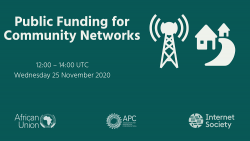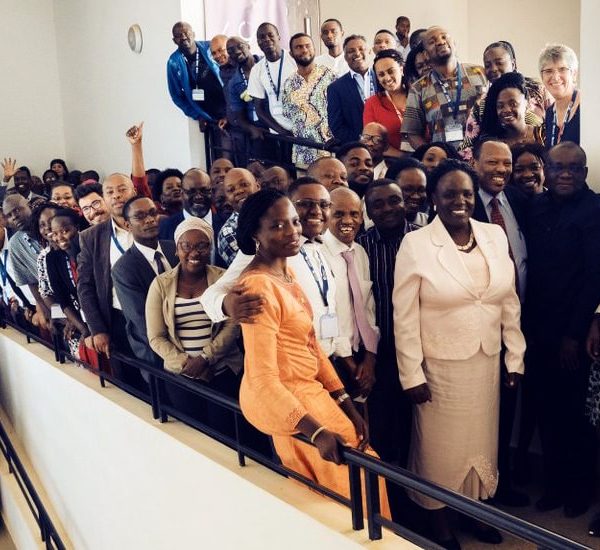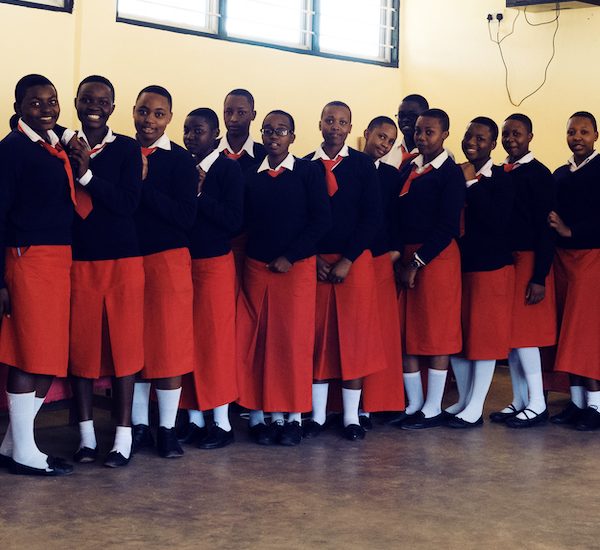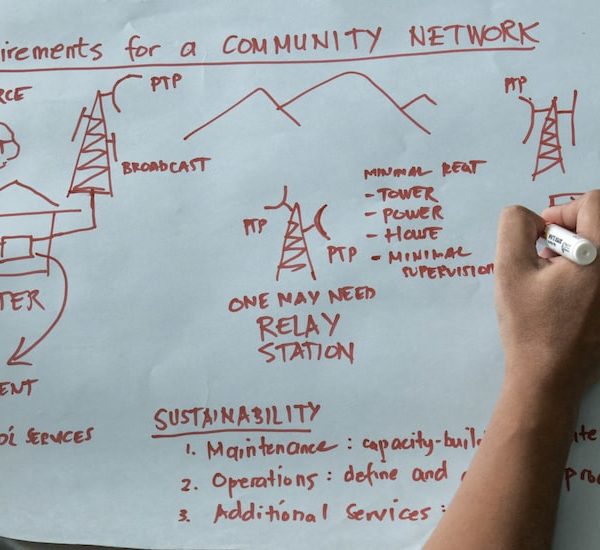Webinar Summary Report
Most countries have some public funding available in the form of universal service funds, access funds, or others where commercial telecommunications are supposed to subsidize areas of market failure. However, in many cases, such funds have piled up unused, and in others, they have been misused. Community networks (CNs), for their part, are often unaware of such funds.
Overview of event
The main objective of the third webinar was to expose the participants to the existence of public funds such as universal service funds and access funds by explaining to them the nature and mandates of such funds that could facilitate the development of Community Networks.
The session explored how Community Networks can tap into such public funds and identify possible existing partnerships for collaboration. Over 85 participants attended the webinar. Mr. Verengai Mabika, who is the Senior Policy Advisor at ISOC and part of the Global Public Policy team gave a background about the topic and welcomed the panel team who dived into more comprehensive discussions. The session, which was the last of the series in 2020, was followed by an interactive social event through the Gather Town online platform where participants connected with each other for further discussions.
Panelists
Panelists included the following experts:
- Dr. Charley Lewis – Independent Analyst, Researcher and Educator
- Nthabiseng Pule – Project and Outreach Manager for the Cybersecurity Capacity Center for Southern Africa (C3SA). She is the former Head of the Universal Access Fund (USF), an Agency of Lesotho’s Communications Authority.
- Victor Asante – Senior Manager in charge of research, monitoring and evaluation at Ghana’s Universal Service Fund, the Ghana Investment Fund for Electronic Communications (GIFEC).
Eleanor Sarpong – Deputy Director and Policy Lead, A4AI, moderated the session. Eleanor leads policy and advocacy efforts with particular oversight on all A4AI’s country engagement work in Asia, Africa, and Latin America.
Panel discussion
The moderator set the tone of the conversation by defining public funds, particularly Universal Service Funds as specified percentage tax of gross revenues pooled together from Internet service providers or mobile operators towards increasing connectivity to underserved communities. She noted with concern that in many African countries, a lot of these funds are being collected but are not being utilized. Additionally, for those that use it, there is a huge challenge with some of the administration of the funds in ensuring its equitable distribution of the fund or to ensure that the funds are being used to connect and serve communities.
How Universal Service Funds are operating in Africa
The objective of creating the Universal Service Fund was to close the digital access gaps. At the time it was originally conceived, there were fixed telephones especially in Africa but then soon after, there came mobile telephones. The mobile technology then became one of the solutions for digital services to close the coverage gaps. As such, when there was sufficient collection, in Lesotho for instance, the amounts were disbursed for mobile network expansion or other activities that were meant to build the internet ecosystem.
Drawing from his experiences, Dr. Charley Lewis shared about Universal Service Funds in relations to Community Networks, particularly in South Africa.
Findings from a recent research revealed that almost 60% of the 37 Community Networks (CNs) in Africa were in South Africa. Additionally, the research showed that of the 80% that were active, most of them were in one form or another, dependent on some kind of external funding in order for them to function.
Furthermore, research results by the Alliance for Affordable Internet (A4AI) revealed that there were about 37 Universal Service Funds across Africa. However, all the findings on the USFs identify three key problematic areas which include; 1) low levels of activity, with less than 65% of funds active; 2) lack of transparency, with a substantial number not providing any form of reports; 3) failure to disperse funds. The A4AI suggests that only just over half of the money raised for the funds is actually spent on projects of one kind or another, with an estimate of around $400 million U.S lying unutilized in funds in Africa.
On what has led to what we see as funds not being utilized or spent on Community Networks, the panelist shared that sometimes, most of the Funds do not receive any applications from Community Networks. However, this is attributed to the lack of awareness among Community Networks about the existence of such funds and the lack of awareness about the concept of Community Networks among Universal Service Funds. Secondly, there is need to look into the policies and regulations governing Universal Service Funds, most of which are constrained. For instance, a Community Network that can potentially have access to the fund could apply, but when it comes to the operating licenses there could be delays in acquiring the license or restrictions in terms of coverage. Diverse resource persons need to be brought on board to help policy makers at both regional and national levels.
Recalling his experiences 20 years ago in South Africa, from a project designed for cooperatives to provide services in areas that were not reached by what was largely the fixed line network, Dr. Lewis shared the following interesting lessons from the model in relation to the funding of Community Networks:
- Policy, law and regulation: It is very important that policy makers and regulators are committed to the model that they are implementing. It is also important that linkage between policy, down to regulation is closely aligned. In South Africa for example, it took several years for the license to be issued. It took even longer for the licensees to acquire the licenses and many of them never got access to the necessary spectrum. There was a lot of opposition from incumbent mobile companies and the fixed line company in South Africa.
- Viability of the market: By early 2000, the mobile had overtaken the fixed lines, with more than half of the communities in the identified 27 underserviced communities already owning mobile telephones. By the time some of the licensees from these underserviced communities got their licenses and started their activities – which included selling fixed mobile lines and using VOIP which had just been liberalized – they were competing in a market that was not viable at all.
- Business Models: There were problems with the business model. In the case of South Africa, there was an enormous amount of emphasis on the ownership and control of the model which included communities, women, youth, etc. It created a model that made it difficult to manage the networks they were trying to roll out, and that was far too dependent upon external funding either from the universal service fund or from venture capital and other sources which were often very hard to tap into. Also, the model was highly dependent on charges and voiceover IP. The business model was problematic and led to the failure which would imply for community networks, a clear business model needs to be developed.
- A fourth area of failure was in relation to the Universal Service Fund itself. The process was far too bureaucratic. Of the 27 licensees, less than 10 were able to receive any funding from the fund, which meant that funding was a particular problem.
Awareness
The panelists emphasized about awareness from both parties to close the knowledge gap. There are assumptions that Universal Service Funds understand the concept of Community Networks, which is most of the time not the case. As such, Community Networks are encouraged to do some proactive engagements with the Universal Service Funds to bridge the knowledge gap and raise more awareness about the model and its sustainability measures. Additionally, the Universal Service Funds are encouraged to be involved in proper workshops and consultation processes with stakeholders in efforts to identify Community Networks as a valuable means of addressing the digital divide and possibly earmark funding for such processes and create awareness about the opportunities among the communities so that they can also try to tap into the funds that are available.
One of the approaches to convene the communities and other stakeholders is to work through the traditional leaders like the local chiefs to mobilize the community and create awareness about the concept of Community Network and availability of funds. Involving them in case studies to contribute to how they can get better services is a way of instilling in them a sense of ownership. Their motivation could be then to solve their own problems themselves as a community if given the opportunity. Also, liaising with the local ISOC chapters and initiatives such as the Affordable Internet Ghana Coalition (AIGC) in Ghana, are partnerships which are able to open up the ecosystem for more opportunities and for funding opportunities to start Community Networks.
Questions, opinions and suggestions from participants
The Question and Answer session attracted a number of comments and questions from the participants mainly on issues related to access to funds, transparency and unused funds.
In response to the issue about what the interests of the Universal Service Funds when giving funds to specific Community Networks were, the panelists shared that it is very important for the applicant to look into what the rules of the funds are and identify what mechanisms are set out ether in the legislation or by the administrator of the fund or both. The applicant will need to know if the rules can be utilized in order to access the funds. On how to ensure that funds actually reach the rightful beneficiaries and serve the designated purposes, they said implemented projects need to be supported by research to document the statuses, processes undertaken, the challenges and opportunities and recommended strategies that could turn around the failed projects if any. The findings could inform the approaches to subsequent projects.
Interventions needed to harmonize the role of Universal Service Funds with Community Networks
Going forward, Universal Service Funds should make sure there is an enabling legal and regulatory framework and also try to find a way of spending money in the funds to the collection. There’s a need to advocate for the concept of Community Networks among Universal Service Funds and create awareness about the existence of such funds to the Community Network fraternity.
Secondly, there is also a need to make sure that the rules of the fund cater for Community Networks. In South Africa, for instance, the fund is specifically restricted to providing support to what they call needy persons. It does include support for network rollouts, so there is a potential avenue for community networks there. But that needs to be driven by the people managing the fund.
As we move into an era of dynamic spectrum allocation and local spectrum licensing, there’s an enormous opportunity for Community Networks to make a space for themselves in underserviced communities. To close the knowledge gap, structure and convene an umbrella body of different stakeholders; Community Networks across the African continent, policy makers, regulators, Universal Service Funds and administrators of the funds to share experiences, identify common problems and share research successes and failures in order to make Community Networks successful.
Conclusion
Connectivity has become a lifeline. As we go into 2021 through to 2030, we want to make sure that we are looking at all the options that are available for connectivity. Evidently, a Community Networks presents not just its roles in connecting the underserved but its ability to have a framework that works for everyone to enjoy the benefits of connectivity. Overall, the road is a challenging one, but with proper policy, regulation and careful integrated planning, it is possible to see Community Networks thrive and flourish across Africa.
Written by Lillian Achom, Co-founder, AccessPlus and PC co-chair, Summit on Community Networks in Africa



